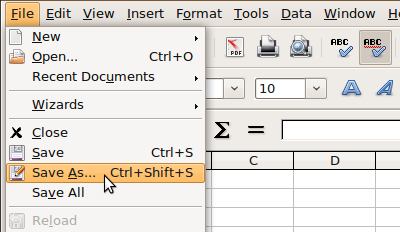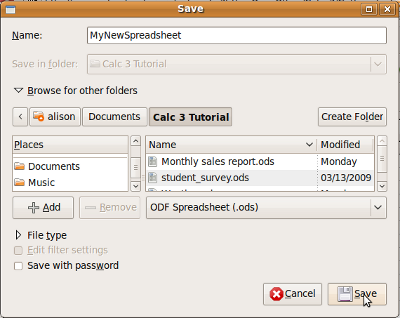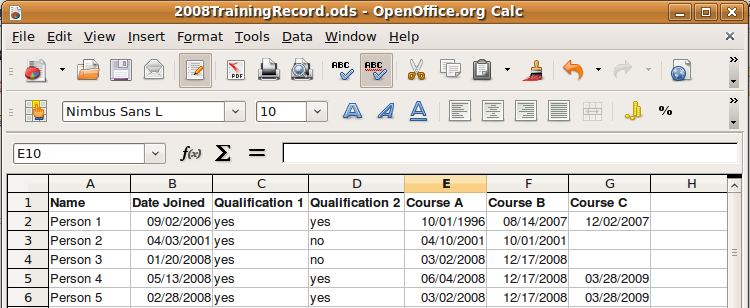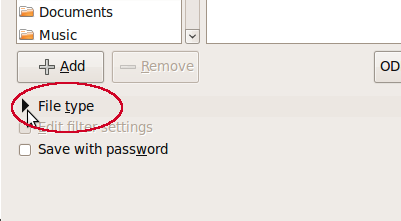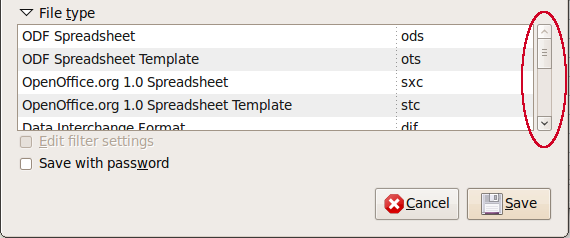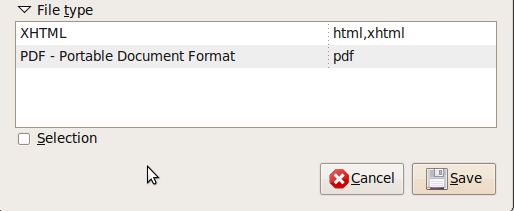Saving spreadsheets
| Working with Spreadsheets in OpenOffice.org Calc | ||
|---|---|---|
| The application | Making a spreadsheet | The Calc screen | Saving | Handling worksheets | Practice | Summary | |
Imagine that the spreadsheet you have open contains important data. At this stage your work is located in the RAM of the computer. Since RAM is volatile, the contents will be lost if the computer is switched off, for example your electricity goes out. In order to preserve your spreadsheet for later use it must be saved on the hard drive of the computer or a mobile storage device such as a floppy disk or a memory stick.
Below are instructions for saving your spreadsheet in a chosen location, under a different name and in different formats.
The basics for saving a file
To avoid losing your work, make a habit of saving your spreadsheet soon after you begin working.
As you work in a spreadsheet, you should save your work frequently. There are three ways to do so:
- Select File > Save on the Menu toolbar.
- Use the key combination Ctrl+S.
- Select the Save button,
 , on the Function toolbar.
, on the Function toolbar.
Save a spreadsheet under another name
What if you want to make a new spreadsheet but you want to begin with one you already have. For example, your group's training record for this year will be set up exactly like last year's record, so why start from scratch to create it. What you want to do is open the starting file, and then save it with a different name.
Suppose we have last year's spreadsheet open as shown below. The spreadsheet has the name 2008TrainingRecord.ods.
Choosing File > Save saves the spreadsheet displayed to the same name.
To save the file to a new name, for example 2009TrainingRecord.ods:
- Select File > Save As....
The Save dialog displays. Revise the name displayed in the name box at the top, and if needed, choose a new location using the Places and Name boxes.
Save in another file type
Sometimes you will want to convert your OpenOffice.org spreadsheet into another format, for example, a csv text file that can be opened using a word processor. Alternatively, you may wish to save the spreadsheet in a format used by another spreadsheet program such as Microsoft Excel.
The following table lists some of the main file formats available with a brief explanation of each.
| File type | Extension | Explanation |
|---|---|---|
| OpenOffice.org Spreadsheet | ods | The standard format for a Calc file. |
| OpenOffice.org Spreadsheet template | ots | A template is an outline for new files, including text, values, formulas, and formatting that are automatically inserted when a new file is created using the template. |
| dBase | odb | A format used by some database programs. These databases would then be able to access the data in the spreadsheet and work with it as if it had been created by a database. |
| Microsoft Excel | xls | Although Microsoft Excel is also a spreadsheet, it uses a different format. By saving the spreadsheet in the xls format, it could be opened directly by Microsoft Excel. |
| Web Page | html | In order to read files, web browsers need to have them saved in a special format known as HTML or Hypertext Markup Language. |
| Text CSV | csv | Called a comma separated file: each row is converted into a paragraph and the columns of the spreadsheet are separated by commas. csv files are used often in data transfers from one application to another. |
| Data Interchange format | dif | An industry standard for exchanging data between different types of applications. |
| Portable Document Format | A file format designed to enable printing and viewing of documents with all their formatting (typefaces, images, layout, etc.) appearing the same regardless of what operating system is used. A pdf document looks the same on Windows, Macintosh, Linux, etc. Pdf files are viewable using Adobe Acrobat Reader. In Calc, Pdf files are created by selecting Export as PDF... in the File menu. |
Save multiple versions
On the file menu there is an option called Version that allows you to save different versions of the spreadsheet in the same file. Keeping versions of a spreadsheet might be useful when a spreadsheet will be revised a number of times before being finalized. Each draft in the revision process can be saved as a version.
To save a file as a version,
- Select File > Versions....
- Select Save New Version in the Versions dialog.
- Enter comments in the text box about the current version: reviewer names, major changes, ....
- Click OK.
The new version is now listed in the Versions dialog, showing date/time, saved by, and comments.
When you want to open a version of a file, select File > Versions... and choose the version you want to open.
